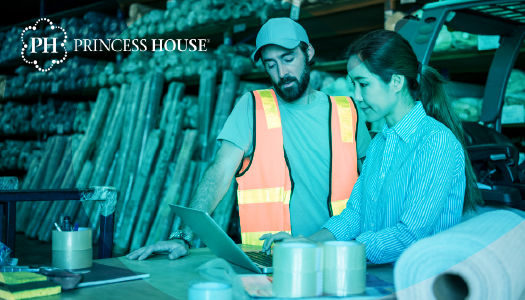Market Overview: Trends and Challenges Facing the Paper & Packing Industries
According to the Pulp and Paper Market Size, Share & Industry Analysis Report, the global paper and pulp industry market size is valued at $360 billion as of 2024 and is expected to grow to over $391 billion by 2032 at a 1% compound annual growth rate (CAGR). Additionally, the paper market size in the U.S is expected to grow exponentially with a target of $53 billion by 2032. Contributing to this fast-paced growth is the higher consumer product demands in an increasingly competitive marketplace. Similarly, in a recent report by the Packaging Market Size, Trends, & Growth Report, the packaging market size is expected to reach $1.3 trillion by 2030, growing at a CAGR of 3.8%.
The paper and packing industries are two of the biggest industries across the globe, with a rich history dating back centuries. Today, countries like India and China are leaders in global paper production by volume. Paper is made primarily from pulp, sourced from wood, rags, and fibers like straw and grass. The surge in demand for paper-based packaging, driven by a shift from plastic to recyclable products, is reshaping the industry.
As the industry transforms, companies today must face a delicate balance between adopting advanced technologies, ensuring regulatory compliance, and maintaining a competitive edge.
Challenges faced by paper & packing manufacturers
Some few of the challenges that paper and packing manufacturers are faced with today include
Limiting environmental impacts
Paper manufacturing is a resource-intensive process, consuming significant amounts of water and energy compared to other industries. With the growing emphasis on sustainability, companies are introducing innovative, eco-friendly products to meet consumer demand for recycled materials. Recent studies have shown that advanced wastewater treatment technologies, like coagulation, have emerged as effective solutions to meet regulatory standards by reducing chemical oxygen demand (COD) in effluents.
Navigating operational and economical hurdles
One of the major challenges in the current economy is the availability of wood pulp due to factors such as global warming, wildfires, and deforestation. Countries with lower labor costs are also driving demand for paper imports, contributing to price fluctuations and increased production costs. Additionally, sustainability practices pose a unique challenge in the paper industry, especially when producing recycled paper. It is a costly process in the current manufacturing environment because it is more complex than how paper is traditionally manufactured.
Maximizing profitability
Profitability in the paper industry hinges on minimizing operational costs and maximizing margins. For instance, fiber sourced from countries like Brazil is a relatively inexpensive raw material that helps boost profits. However, with a volatile supply and demand landscape, manufacturers must closely monitor market trends and differentiate their offerings to remain competitive.
To improve profitability, manufacturers are tapping into various strategies, including:
Customization: Offering personalized options such as colors, sizes, and printing information allows manufacturers to adjust pricing and appeal to specific consumer preferences.
E-commerce expansion: Providing a virtual shopping experience enables businesses to diversify their product lines and reach a broader audience.
Bundle offers: Combining multiple products into a single, discounted package is a proven method for moving slow-moving inventory and simplifying the buying process for consumers.
Key trends in the paper & packaging industries
The rise of online shopping has led to an increase in packaging waste, prompting manufacturers to explore more sustainable solutions. The demand for graphic paper has declined, while industrial, tissue, and consumer packaging have seen rapid growth. This shift is encouraging traditional paper manufacturers to adopt new technologies, which improve distribution and supply chain efficiencies, and will have a significant positive impact on profits over time.
Some other key trends shaping paper and packaging industries in 2025 include:
Biodegradable packaging
As consumers prioritize sustainability, companies are increasingly turning to biodegradable materials to replace plastics. Plant-based packaging solutions are gaining popularity for being eco-friendly and often more affordable than plastic alternatives.
Robotics and automation
Labor shortages are one of the biggest pain points in manufacturing as a whole, and the packaging industry is not exempt. One alternative to overcome this ongoing challenge is to lean into automation.
Some examples include installing robotics to palletize finished products or implementing technology such as sensors to sort/filter bad vs good products, and even QR codes. Installing new advanced technology comes with enhanced capabilities which support an increase in the overall productivity and profitability of paper and packaging manufacturers.
Industrial Internet of Things (IIoT)
The Industrial Internet of Things, or IIoT, refers to some of the most advanced technologies in manufacturing. IIoT technologies can offer manufacturers real-time insights into asset performance, allowing them to detect potential equipment failures and schedule preventive maintenance. This can significantly reduce unnecessary equipment downtime, increase overall asset life expectancy, and improve overall organizational efficiency and productivity.
Sustainability
Producing sustainable products is a key focus in a changing manufacturing environment. Since 2020, end consumers are more concerned about product hygiene and traceability of the product’s components. Packaging manufacturers are heavily investing funds in finding innovative packaging materials to keep up their market presence.
Conclusion
The paper and packaging industries face a number of challenges ranging from labor shortages to supply chain disruptions and raw material uncertainties. However, with the adoption of advanced technologies like CMMS, data analytics, and IIoT, manufacturers are better positioned to navigate these obstacles and achieve sustainable growth. As demand shifts from traditional paper products to packaging materials, companies must innovate to stay competitive in a rapidly evolving market.
If you’re ready to take the next steps on your journey to navigate the challenges facing the paper and packing industries, learn more about Brightly’s IoT for smarter asset management.




